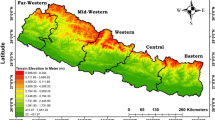Abstract
Standard observations at 20 weather stations were compared with data of the World Wide Lightning Location Network (WWLLN) in the south of the Russian Far East for the period of 2009–2018. Using two statistical methods, the estimates are obtained of the radii of the circular region of the WWLLN data sample, at which the best consistency of the WWLLN data with the number of days with thunderstorms according to weather station data is observed. It is shown that these radii are in the range from 12 to 36 km for all stations, with an average value of 23 km. Daytime radii are smaller than nighttime ones, the average values for all stations are equal to 21 and 26 km, respectively. It is demonstrated that an increase/decrease in the radius of the WWLLN data sample by 1 km relative to the average value leads to an increase/decrease in the average annual number of days with WWLLN lightning strikes relative to weather reports by \(\sim\)1 day.



Similar content being viewed by others
REFERENCES
Database of All-Russian Research Institute of Hydrometeorological Information–World Data Center (ARIHMI–WDC), www.meteo.ru [in Russian].
Manual for Hydrometeorological Stations, Issue 3, Part 1 (Gidrometeoizdat, Leningrad, 1985) [in Russian].
M. S. Permyakov, E. Yu. Potalova, and T. I. Kleshcheva, “Thunderstorm Activity in the Primorsky Krai,” Meteorol. Gidrol., No. 12 (2019) [Russ. Meteorol. Hydrol., No. 12, 44 (2019)].
Guide to Instruments and Methods of Observation (WMO-No. 8) (WMO, Geneva, 2014) [Transl. from English].
A. Kh. Khrgian, Atmospheric Physics, Vol. 1 (Gidrometeoizdat, Leningrad, 1978) [in Russian].
R. E. Burgesser, “Assessment of the World Wide Lightning Location Network (WWLLN) Detection Efficiency by Comparison to the Lightning Imaging Sensor (LIS),” Quart. J. Roy. Meteorol. Soc., 143 (2017).
B. Czernecki, M. Taszarek, L. Kolendowicz, and J. Konarski, “Relationship between Human Observations of Thunderstorms and the PERUN Lightning Detection Network in Poland,” Atmos. Res., 167 (2016).
S. E. Enno, “Comparison of Thunderstorm Hours Registered by the Lightning Detection Network and Human Observers in Estonia, 2006–2011,” Theor. Appl. Climatol., 121 (2015).
M. L. Hutchins, R. H. Holzworth, C. J. Rodgers, S. Heckman, and J. B. Brundell, “WWLLN Absolute Detection Efficiencies and the Global Lightning Source Function,” in EGU General Assembly, Vienna, Austria, April 22–27, 2012, http://adsabs.harvard.edu/abs/2012EGUGA..1412917H.
M. Permyakov, T. Kleshcheva, E. Potalova, and R. H. Holzworth, “Characteristics of Typhoon Eyewalls According to World Wide Lightning Location Network Data,” Mon. Wea. Rev., No. 11, 147 (2019).
A. T. Pessi, S. Businger, K. L. Cummins, N. W. S. Demetriades, M. Murphy, and B. Pifer, “Development of a Long-range Lightning Detection Network for the Pacific: Construction, Calibration, and Performance,” J. Atmos. Ocean. Technol., 26 (2009).
R. M. Reap and R. E. Orville, “The Relationships between Network Lightning Locations and Surface Hourly Observations of Thunderstorms,” Mon. Wea. Rev., 118 (1990).
D. S. Wilks, Statistical Methods in the Atmospheric Sciences (Academic Press, 2006).
World Wide Lightning Location Network (WWLLN), http://wwlln.net.
Author information
Authors and Affiliations
Corresponding author
Additional information
Translated from Meteorologiya i Gidrologiya, 2021, No. 6, pp. 89-98. https://doi.org/10.52002/0130-2906-2021-6-89-98.
About this article
Cite this article
Kleshcheva, T.I., Potalova, E.Y. & Permyakov, M.S. Comparison of World Wide Lightning Location Network (WWLLN) Data and Standard Observations at Weather Stations in the Southern Russian Far East. Russ. Meteorol. Hydrol. 46, 403–409 (2021). https://doi.org/10.3103/S1068373921060078
Received:
Published:
Issue Date:
DOI: https://doi.org/10.3103/S1068373921060078




